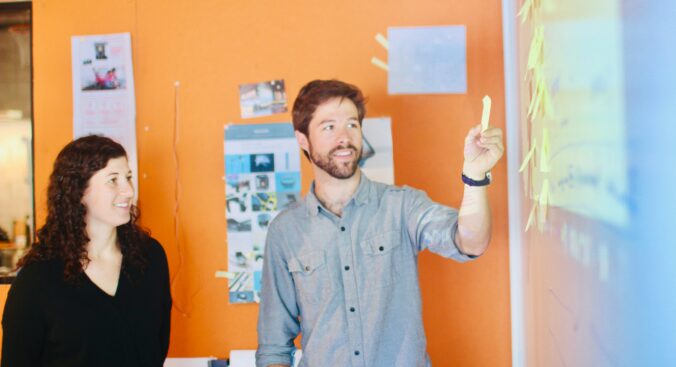Navigating Innovation: The Current Landscape of Design Thinking in Corporate Teams

In the ever-evolving landscape of business and innovation, design thinking has historically been viewed as a powerful tool for corporate innovation teams. A recent Fast Company article proclaimed that staff cuts at design consultancy IDEO signaled the “end of the design thinking era.” (cue sound of needle being dragged across a record) What?!?! Hold up. Let’s set the hyperbolic click-bait aside and think about this.
Over the years design thinking has moved beyond its initial boundaries in product and user experience design to become a go-to approach for creativity, collaboration, and problem-solving within corporate environments. Let’s take a quick look at the current state and decide for ourselves what role design thinking can and should be playing in our innovation toolkit.
Background
If you’re reading this post you likely know the basic design thinking manifesto of empathy, iteration and user-centric problem solving. It typically is defined with five fundamental stages —empathize, define, ideate, prototype, and test—that compose the basic framework. You likely also know that design thinking goes beyond aesthetics and can be readily applied to an array of challenges.
Pros of Design Thinking in Corporate Innovation Teams
Let’s remind ourselves what we like about this framework…
- User-Centric Solutions: Design thinking makes the end-user the north star of the innovation process, yielding solutions that are focused on the needs and pain paints of actual users.
- Enhanced Collaboration: Design thinking encourages cross-department collaboration, breaking down silos within corporate teams and fostering a culture of collective problem-solving.
- Iterative Problem-Solving: Design thinking advocates an iterative approach, allowing teams to refine and improve solutions based on feedback and testing.
- Risk Mitigation: Design thinking involves end-users as the very first step in the process, reducing the risk of developing products or solutions that may not resonate with the target audience.
- Mindset Shift: Design thinking adoption can lead to a cultural shift within organizations and support and de-mystify the innovation process.
Challenges of Design Thinking in Corporate Innovation Teams
Nothing is perfect. Common criticisms of the design thinking approach include…
- Time-Consuming: The thorough exploration and iteration involved in design thinking can be time-consuming, which may be a challenge in fast-paced corporate environments.
- Subjectivity: The reliance on qualitative data and subjective insights make some uncomfortable and can complicate measuring the success or failure of design thinking outputs in quantifiable terms.
- Overemphasis on Empathy: A focus on user empathy without balancing business viability and technical feasibility may lead to impractical solutions.
Re-Designing Design Thinking for Optimal Results
We’re a pragmatic bunch here at Clearworks. We often modify tools and frameworks to suit our needs. Similarly, smart corporate innovation teams are not blindly adhering to a one-size-fits-all design thinking approach. Instead, they are tailoring the methodology to meet their own needs and challenges:
- Agile Integration: Teams are integrating design thinking principles with agile development methodologies, creating a quicker and more responsive innovation process.
- Design Sprints: Some teams are adopting design sprints — essentially a condensed version of design thinking that compresses the process into a shorter timeframe.
- Incorporating Technology: Teams are experimenting with how advanced technologies like AI and data analytics can be incorporated into the classic design thinking stages to enhance things like concept ideation and prototype development.
- Remote Collaboration: The shift to remote and hybrid work has prompted teams to adapt design thinking for virtual collaboration. Digital tools and platforms have matured and can now enable virtual workshops, ideation sessions, and user testing.
Conclusion
Design thinking is not dead. The era of design thinking is not over. Perhaps a bit out-of-fashion for the moment? But call it whatever you want… the basic framework of empathy, collaboration and iteration still makes as much sense today as it did twenty years ago. Teams are finding innovative ways to customize and integrate design thinking principles ensuring that it remains a relevant and effective approach in the ever-changing landscape of corporate innovation.
Share this blog post: